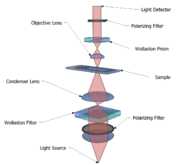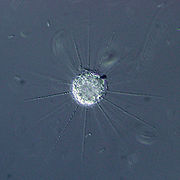Differential Interference Contrast
- Differential Interference Contrast
-
Der Differentialinterferenzkontrast (auch: Differential-Interferenz-Kontrast oder Nomarski-Kontrast, abgekürzt DIC von englisch Differential Interference Contrast) ist eine Methode der abbildenden Durchlicht-Mikroskopie, die Unterschiede in der optischen Dichte des betrachteten Objektes in Kontrastunterschiede des Bildes umwandelt. Mit diesem Verfahren lassen sich sehr eindrucksvolle pseudo-plastische Bilder erstellen, die allerdings nicht die wahren räumlichen Strukturen wiedergeben.
Geschichte
DIC wurde in den 1950er Jahren von Georges Nomarski in Paris entwickelt; das CNRS hielt die Lizenz für dieses Verfahren. Die erste serienmäßige Anwendung baute die Firma Carl Zeiss in Oberkochen. In der Folgezeit haben nur die großen Mikroskophersteller das anspruchsvolle Verfahren in ihr Programm übernommen.
Prinzip

Mikroskopische Komponenten bei DIC-Mikroskopie. Statt eines Wollaston-Prismas wird in der Regel ein Nomarski-Prisma verwendet.
Neben dem üblichen Mikroskopaufbau werden zusätzlich je ein Nomarski-Prisma, das aus zwei Kalkspatkeilen besteht, und je ein Polarisationsfilter vor dem Kondensor und hinter dem Objektiv eingebaut. Das Kondensor-Prisma sorgt für die Aufspaltung des Beleuchtungsstrahlbündels in zwei parallele, senkrecht zueinander schwingende Strahlen, die einen Versatz unterhalb der Auflösungsgrenze des Mikroskopobjektives aufweisen. Beide Strahlen werden nach dem Durchgang durch Präparat und Objektiv im darüber befindlichen Objektiv-Prisma wieder zusammengeführt und können so interferieren, nachdem ihre Polarisationsrichtungen durch den Filter vereinigt wurden. Falls die beiden Teilstrahlen durch ein Gebiet unterschiedlicher optischer Dichte gelaufen waren, wird ein Kontrast erzeugt (destruktive Interferenz, ansonsten wird die ursprüngliche Intensität vor der Strahlteilung wieder erreicht.
Da die Teilstrahlen senkrecht zueinander polarisiert sind, werden durch Drehung des Mikroskoptisches unterschiedliche Darstellungen des Objektes möglich. Durch Einbau eines λ/4-Plättchens kann zusätzlich ein Farbkontrast erzeugt werden.
Im Gegensatz zur Phasenkontrastmikroskopie kann die maximale Kondensor-Apertur verwendet werden. Dadurch steigt sowohl die Lichtintensität als auch die Auflösung des Bildes.

Strahlengang bei DIC-Mikroskopie. Entscheidend sind die beiden Polarisationsfilter und die beiden Wollaston- oder Nomarski-Prismen.
Siehe auch
Weblinks
Wikimedia Foundation.
Schlagen Sie auch in anderen Wörterbüchern nach:
Differential interference contrast microscopy — Micrasterias furcata imaged in transmitted DIC microscopy. Differential interference contrast microscopy (DIC), also known as Nomarski Interference Contrast (NIC) or Nomarski microscopy, is an optical microscopy illumination technique used to… … Wikipedia
differential interference contrast — Method of image formation in the light microscope based on the method proposed by Nomarski (though strictly speaking all forms of optical microscopy rely to a greater or lesser extent on differential interference). The light beam is split by a… … Dictionary of molecular biology
Nomarski differential interference contrast — See differential interference contrast … Dictionary of molecular biology
differential interference contrast — (DIC) microscope A light microscope that employs two beams of plane polarized light. The beams are combined after passing through the specimen and their intereference is used to create the image … Dictionary of microbiology
Interference microscope — might refer to: * Classical interference microscopy (interference between well separated beams) * Differential interference contrast microscopy (also called Nomarski Interference Contrast or Nomarski microscopy) * Fluorescence interference… … Wikipedia
Interference microscopy — involving measurements of differences in the path between two beams of light that have been split.[1] Types include: Classical interference microscopy Differential interference contrast microscopy Fluorescence interference contrast microscopy See … Wikipedia
Differential-Interferenz-Kontrast — DIC Aufnahme des Sonnentierchens Raphidiophrys contractilis Der Differentialinterferenzkontrast (auch: Differential Interferenz Kontrast oder Nomarski Kontrast, abgekürzt DIC von englisch Differential Interference Contrast) ist eine Methode der… … Deutsch Wikipedia
Phase contrast microscopy — Phase contrast image of a cheek epithelial cell Phase contrast microscopy is an optical microscopy illumination technique of great importance to biologists in which small (invisible to the human eye) phase shifts in the light passing through a… … Wikipedia
Classical interference microscopy — (also referred to as quantitative interference microscopy) uses two separate light beams with much greater lateral separation than that used in phase contrast microscopy or in differential interference microscopy (DIC). In variants of the… … Wikipedia
Microscopy — is the technical field of using microscopes to view samples and objects that cannot be seen with the unaided eye (objects that are not within the resolution range of the normal eye). There are three well known branches of microscopy, optical,… … Wikipedia
 DIC-Aufnahme des Sonnentierchens Raphidiophrys contractilis
DIC-Aufnahme des Sonnentierchens Raphidiophrys contractilis

